Hemis Festival / Image Credit
Come the 10th day of the fifth month of the Tibetan calendar and Hemis Gompa, the largest and wealthiest monastery in Ladakh, plays host to one of the most important festivals of Ladakh. For visitors seeking a rendezvous with the unique Ladakh’s culture, the two- day Hemis Festival makes for a great opportunity offering them a matchless spectacle of masked dances, traditional music, religious rituals and ceremonies and a lifetime opportunity to sample the delicious cuisines of Ladakh.
Hemis Festival commemorates the birth anniversary of Guru Padmasambhava, the founder of the Vajrayana Buddhism in Ladakh. The festival brings out the extroverted side of the famously friendly people of Ladakh. If you want to see the annual Hemis Tsechu festival you will have to come in the months of June and July.
Sitting on a hillock, Hemis Gompa is 40km from Leh and the centerpiece of any visit to Ladakh. During the celebration of the Hemis festival the monastery comes alive with the spectacular mask dance by the lamas to the accompaniment of drums, cymbals and long horns.
During the Hemis Festival you will have the opportunity to sample the rich cuisines of Ladakh in the stalls outside. Here you can also pick up gifts and souvenirs.
Hemis Monastery


Comments
Post a Comment